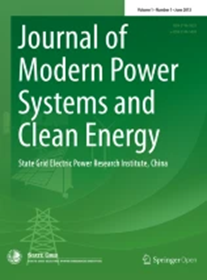Probabilistic Residential Load Forecasting with Sequence-to-Sequence Adversarial Domain Adaptation Networks
IF 6.1
1区 工程技术
Q1 ENGINEERING, ELECTRICAL & ELECTRONIC
Journal of Modern Power Systems and Clean Energy
Pub Date : 2024-03-10
DOI:10.35833/MPCE.2023.000841
引用次数: 0
Abstract
Lately, the power demand of consumers is increasing in distribution networks, while renewable power generation keeps penetrating into the distribution networks. Insufficient data make it hard to accurately predict the new residential load or newly built apartments with volatile and changing time-series characteristics in terms of frequency and magnitude. Hence, this paper proposes a short-term probabilistic residential load forecasting scheme based on transfer learning and deep learning techniques. First, we formulate the short-term probabilistic residential load forecasting problem. Then, we propose a sequence-to-sequence (Seq2Seq) adversarial domain adaptation network and its joint training strategy to transfer generic features from the source domain (with massive consumption records of regular loads) to the target domain (with limited observations of new residential loads) and simultaneously minimize the domain difference and forecasting errors when solving the forecasting problem. For implementation, the dominant techniques or elements are used as the submodules of the Seq2Seq adversarial domain adaptation network, including the Seq2Seq recurrent neural networks (RNNs) composed of a long short-term memory (LSTM) encoder and an LSTM decoder, and quantile loss. Finally, this study conducts the case studies via multiple evaluation indices, comparative methods of classic machine learning and advanced deep learning, and various available data of the new residentical loads and other regular loads. The experimental results validate the effectiveness and stability of the proposed scheme.利用序列到序列逆域适应网络进行住宅负荷概率预测
近来,配电网中用户的电力需求不断增加,而可再生能源发电不断渗入配电网。由于数据不足,很难准确预测新增住宅负荷或新建公寓在频率和幅度方面具有波动和变化的时间序列特征。因此,本文提出了一种基于迁移学习和深度学习技术的短期概率住宅负荷预测方案。首先,我们提出了短期概率住宅负荷预测问题。然后,我们提出了一种序列到序列(Seq2Seq)对抗性域适应网络及其联合训练策略,用于将源域(具有大量常规负荷消费记录)的通用特征转移到目标域(具有有限的新住宅负荷观测值),并在解决预测问题时同时最小化域差异和预测误差。在实现过程中,主要技术或元素被用作 Seq2Seq 对抗性域适应网络的子模块,包括由长短时记忆(LSTM)编码器和 LSTM 解码器组成的 Seq2Seq 循环神经网络(RNN)以及量化损失。最后,本研究通过多种评价指标、经典机器学习和高级深度学习的比较方法以及新居民典型负荷和其他常规负荷的各种可用数据进行了案例研究。实验结果验证了所提方案的有效性和稳定性。
本文章由计算机程序翻译,如有差异,请以英文原文为准。
求助全文
约1分钟内获得全文
求助全文
来源期刊

Journal of Modern Power Systems and Clean Energy
ENGINEERING, ELECTRICAL & ELECTRONIC-
CiteScore
12.30
自引率
14.30%
发文量
97
审稿时长
13 weeks
期刊介绍:
Journal of Modern Power Systems and Clean Energy (MPCE), commencing from June, 2013, is a newly established, peer-reviewed and quarterly published journal in English. It is the first international power engineering journal originated in mainland China. MPCE publishes original papers, short letters and review articles in the field of modern power systems with focus on smart grid technology and renewable energy integration, etc.
 求助内容:
求助内容: 应助结果提醒方式:
应助结果提醒方式:


